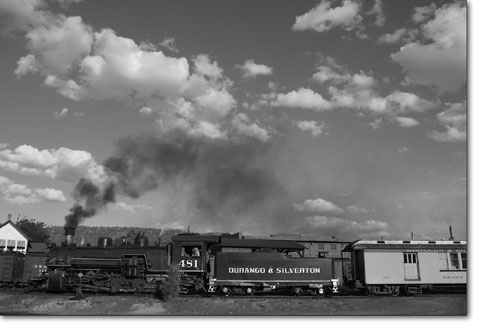|
| ||
| Clearing the smoke SideStory: In search of the perfect fix: D&SNG begins to implement solutions
by Will Sands The smoke is beginning to lift over Durango’s south side. A collaborative effort between the Durango & Silverton Narrow Gauge Railroad and local residents is closing in on the goal of mellowing the impacts of the train’s coal smoke on south Durango neighborhoods. Coal smoke has long been a point of contention on Durango’s south side, thanks largely to “hot standby,” the process where up to four D&SNGRR locomotives remain stoked with coal and idle overnight. The smoke from the engines follows prevailing winds, often blowinginto homes on the south side. Last summer, the San Juan Basin Health Department heard community concerns and took a hard look at air quality on Durango’s south side. The department started with a study of particulates. “We’ve certainly determined that disproportionate amounts of the particulate concentration in south Durango comes from coal-fired locomotives,” said Wano Urbonas, San Juan Basin’s environmental health director. “There’s no pollution level that’s safe, but the amounts we’re finding continue to be lower than any exceedance level.” In spite of this compliance, the D&SNGRR heard community concerns and willingly came to the table for a brainstorming session in early February. Immediately after, Allen Harper, the train owner, stated his commitment to mitigate smoke and launched an action committee to consider alternatives to the current “hot standby.” Steve Jackson, chief mechanical officer with the train, explained that the train is interested in working toward a mutually agreeable solution. “We had a brainstorming session with residents of the south side and talked about a number of things,” Jackson said. “During the next phase, we’ll look at implementing some ideas. We’re already adding over-fire jacks in the fireboxes to get more efficient combustion, and we’ve added another engine watchman in hopes that we can fire them a little lighter.” Sarah Wright, one of the neighborhood participants in the dialogue, expressed the group’s gratitude to the railroad for coming to the table and working toward a solution. Throughout the process, Harper and the railroad encouraged neighborhood input and involvement in getting the emissions down to a reasonable level. “D&SNGRR seems genuinely 4 committed to improvements,” Wright said. “It’s not an easy task. The most pressing question is determining the best technical solutions and then how to obtain funding once solutions are determined.” Urbonas concurred that finding the perfect technology will be challenging. To that end, the health department has commissioned the Denver consultant, EarthTech, to undertake a study on potential alternatives to “hot standby.” “The train has voiced willingness,” Urbonas said. “Now, I think we need to come up with an actual action plan to get to the next level. The question is, ‘Who is going to take the next step and what kind of technology will we try?’” Urbonas credited the train’s current wet scrubber system for reducing emissions. However, the fact that the scrubbers are shut down seven months of the year is problematic, he added. “If we are going to generate the pollution, we are going to have to find a way to control it,” he said. Funding alternatives is another great unknown, according to all the players. Jackson noted that the financially beleaguered railroad already has a great deal invested in the scrubber system. With this in mind, the train will likely will have to look to grants and partnerships for further fixes. “There’s a coalition we’re trying to establish with the neighborhood and city, county, state and even federal officials,” Jackson said. “We don’t know what design we’ll go with or what it will cost. But as we continue to develop this, we realize that we’ve already got about $400,000 in it now and considerable operational costs.” Getting all the players on board could make a south side coal fix more attractive to federal grants, according to Wright. In particular, the groups are hoping to attract participation from La Plata County and the City of Durango. “City Councilor Renee Parsons and County Commissioner Wally White have been personally involved, and La Plata County and City of Durango managers Michael Scannell and Bob Ledger have expressed an intention to actively participate in this process,” Wright said. “Their involvement is crucial.” Finding a near-term solution to the south side haze is also crucial from a different perspective. Prompted by concerns about the D&SNGRR’strian’s smoke, the Colorado Department of Health and the Environment is analyzing whether the train is actually exempt from the Clean Air Act, as has long been believed. Margie Perkins, the director the department’s air quality division, noted that act contains a general exemption for locomotives. “But there is a lengthy discussion on who can take this exemption and when they can take it,” she said. “Right now, we’re still doing the analysis on whether the exemption actually applies to the Durango train.” The D&SNGRR’s current compliance with the act could be in danger, if Perkins finds that the train is no longer exempt. “If this exemption does not apply, we have to raise the question of whether there are any state regulations being violated in Durango,” she said. “We’ll know in a short time. I’m hoping to have this all out on the table reasonably soon.”
|
In this week's issue...
- May 15, 2025
- End of the trail
Despite tariff pause, Colorado bike company can’t hang on through supply chain chaos
- May 8, 2025
- Shared pain
Dismal trend highlights need to cut usage in Upper Basin, too
- April 24, 2025
- A tale of two bills
Nuclear gets all the hype, but optimizing infrastructure will have bigger impact


